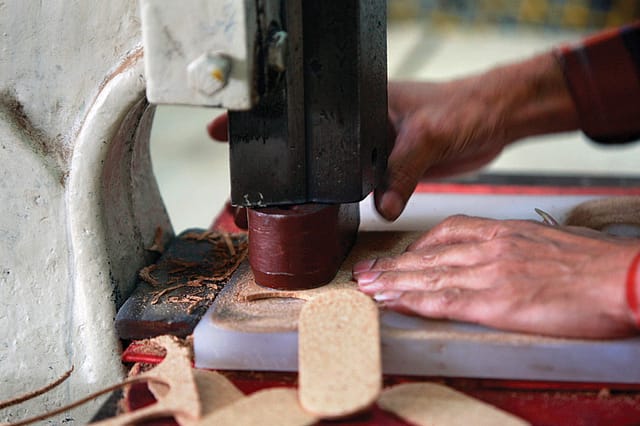The Making of a Cricket Ball

It takes 75 days to make, and lives for a day.
A cricket ball's life is hard-earned and short. Before it is ready for a pounding, it is hung, soaked, stretched, and has its lips stitched. Afterward the beating is more external. But it lives for one day, and that is its place in life.
The Sanspareils Greenlands (SG) factory in Meerut has a monopoly on quality balls in India. The best balls find their way into the hands of Zaheer Khan and Ishant Sharma. Domestic bowlers also use these balls. Most school cricket is played with SG balls. Some forms of cricket are profligate with balls. Others, at the lower end, are less so. The idea at SG is to make it last for as long as possible; to ensure that while it lives for a day, it holds its shape and serves the bowlers' interest for as long as possible. That is why it takes 75 days to create a single cricket ball.
The quality of a ball is determined by the quality of hide used to create its shell. An animal that has lived well enhances the quality of the ball. Leather arriving at the factory is white and floppy, and emits a curious smell. An inspector looks for blemishes, such as scratches. These are then cut up, treated chemically, and exposed to direct sunlight. They are transferred to large basins filled with red dye to be stomped on by men wearing rubber boots. If the colour applied is uniform, they progress to the next stage. This is important. Blotches or an uneven spread of colour imply impure leather.
2026 New Year Issue
Essays by Shashi Tharoor, Sumana Roy, Ram Madhav, Swapan Dasgupta, Carlo Pizzati, Manjari Chaturvedi, TCA Raghavan, Vinita Dawra Nangia, Rami Niranjan Desai, Shylashri Shankar, Roderick Matthews, Suvir Saran
While the leather is then massaged, compressed, stretched, and animal fat applied, elsewhere in the factory, the ball's core is prepared. Inside the ball, if you manage to tear open its seam, you will see a tightly wound ball of wool string and strips of rubber-cork. Unravel this covering and a cork-rubber ball will be found. This core is what gives the ball its bounce.
This combination of string, strips and nucleus contain water when they are wound together, and the drying process takes a long time. If it weighs between 95 and 100 grams, the dried core is slipped into two leather half-spheres.
Meanwhile, after the animal fat process, the leather is cut into ovals with pointed ends, and two of these pieces stitched together form a half ball. A clamp presses the half-ball into a dome. At the stage where one dome meets another, the core is placed inside. Then comes the seam, which requires the right kind of thread, and a particular thread count. Official guidelines permit between 78 and 82 stitches. If this is fine, and there are no scratches or inconsistencies in the lacquer coating that will be soon applied, the ball is deemed ready for the last interrogation of its life.
—Rahul Bhatia
